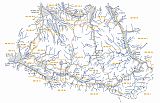Kvalitní cestovní pojištění
do zahraničí i do ČR.
Cestovní pojištění jednoduše, rychle a online na Top-Pojištění.cz s okamžitou platností a se slevou až 50 %.
Nejlevnější cestovní pojištění
na celý rok už od jediné koruny na den.
Moravskoslezské Beskydy (MB)
Moravskoslezské Beskydy: Unit photos | Add photo | Add information
Move on: Burkův vrch | Burkův vrch - Z vrchol | Čertův mlýn | Čuboňov | Javorový | Kněhyně | Lysá hora | Magurka | Malá Stolová | Malý Polom | Malý Smrk | Nořičí hora | Ostrý | Radegast | Radegast - Z vrchol I | Radhošť | Ropice | Slavíč | Smrčina | Smrk | Šindelná | Tanečnice | Tanečnice - Z vrchol | Travný | Velká Stolová | Velký Polom
Related links: Krušné hory | Ještědsko-kozákovský hřbet | Jizerské hory | Krkonoše | Orlické hory | Králický Sněžník | Hanušovická vrchovina | Rychlebské hory | Hrubý Jeseník | Moravskoslezské Beskydy | Hostýnsko-vsetínská hornatina | Javorníky | Novohradské hory | Šumavské podhůří | Šumava | Český les
The Moravskoslezské Beskydy Mountains are classified as a broken range. They lie at the easternmost part of the Czech Republic, by the Slovak Republic border. In the Czech Republic, they form the highest part of the Carpathian Mountains. Their inclusion in the Carpathian curve (part of the Outer Carpathians) is reflected in its typical geological structure, the alternating series of claystone, sandstone and conglomerate (the so called flysch zone). Within the Tertiary Period, whole strata folded and broke up; subsequent water erosion has resulted in the present orography. The edge of the Moravskoslezské Beskydys is a system of ridges which are more or less compact. In the central part are found three majestic massifs Lys á hora (the highest at 1,323 meters above sea level), Smrk and Travný. The vast CHKO Beskydy (protected landscape area) (1,160 km2, the biggest in the Czech Republic) protects also a part of the Javorník and Hostýnsko-vsetínská Mountains. Primarily large forest complexes are being protected, in some places of which the original beech-fir forest has been preserved. After many decades, large animals, such as lynx, wolf and bear, have returned to the forests. The climate of the mountains corresponds accordingly to the elevation. Lysá hora has an average yearly rainfall of about 1,500 mm and is therefore one of the most humid areas in the Czech Republic. During the winter there is typically frequent and substantial snowfall. Many of the local 27 principal thousand-meter peaks are ideal to visit in the winter (for example, Zadní Hory and Ropická Rozsocha). However, it is possible to enjoy the magic of the Moravskoslezské Beskydys in any season. These mountains offer a peak to satisfy anyone’s needs – from Lysá Hora to Radhošť, one can find every conceivable conquest of man, but there are also peaceful and deserted peaks, such as Kněhyně, Ostrý and Ropice.



